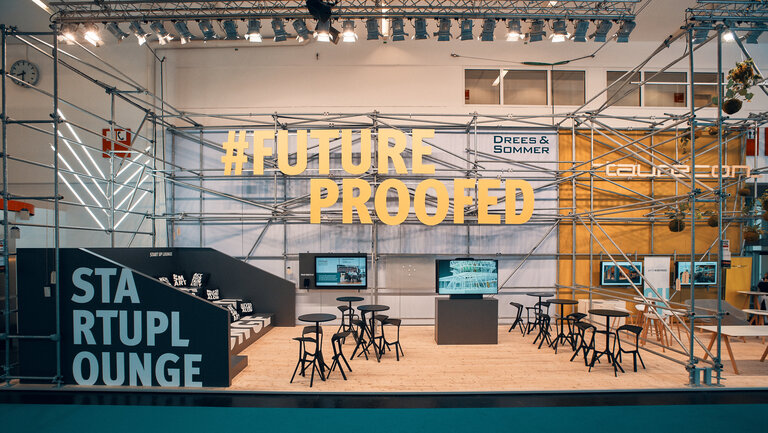Here you can find video statements and information about the new booth.
Printed walls, countless advertising items and an extensive catering service – large events such as trade fairs normally generate large quantities of waste – in only a few days. However, much of this is avoidable or can be designed in a significantly more ecological way. One solution is the Cradle to Cradle design concept which is based on recyclable and healthy products without any negative effects on the climate, fair and efficient manufacturing processes and the potential for permanent reuse of the materials. This innovative concept is already used in many of the construction and real estate projects carried out by Drees & Sommer. But the company's new trade fair booth shows that future-proof and sustainable solutions are decisive not only in buildings with a service life of 30 or 40 years, but also in temporary buildings such as fair booths.
‘With our fair booth inspired by the Cradle to Cradle principle, we want to motivate our clients and other trade fair visitors to develop a greater awareness in their use of resources. In addition, we feel that it is important to set an example for greater sustainability even in the area of exhibition construction and design. The necessary products, tools and concepts are already available for anyone to use,’ says Dr. Peter Mösle, Partner at Drees & Sommer SE and Managing Director of EPEA GmbH – Part of Drees & Sommer. In the design of the booth, Drees & Sommer used its in-house expertise. For example, the experts of the RBS Group were responsible for the design, and the specialists of EPEA GmbH provided consultation on the Cradle to Cradle principle.
They cooperated closely to develop the booth concept which not only placed the focus on the use of sustainable products, but also aimed to reduce to a minimum the amount of waste which arises after the end of the trade fair.
A sustainable fair booth – from the chairs to the lamps
The new fair booth uses high quality and recyclable materials, some of which are certified according to Cradle to Cradle product standards. For example, the wooden structures such as the reception counter, the bench and the seating stand in the booth are made of refined waste wood. The bar is made of Solid Textile Board, a high-density material produced from used textiles and fabric offcuts. The visual framework around the booth consists of C2C-certified textile strips made of 100 percent recycled post-consumer polyester. The solid natural wood floor is made of German-sourced fir and can be returned to the biological life cycle without any contaminants after the end of its service life. And the C2C-certified lamps on the booth are suitable to be returned to the technical life cycle.
The ability to dismantle structures easily is also a contribution to the concept of a genuine circular economy. For example, the steel framework of the booth can be disassembled into individual parts and stored in the warehouse of the fair booth construction partner, Atelier Damböck Messebau GmbH – ready for use in any number of new exhibitions. The chairs that are used are also designed in a way that they are easy to dismantle and can then be returned to high quality reuse or to a recycling process. All of these products and measures create a comprehensively sustainable fair booth which graphically demonstrates the Cradle to Cradle concept and important aspects of the circular economy in a way that is visible to visitors.
